Step into the Daylight
Team Members: Wendy(Siwen Fang) & Melanie(Yuan Quan)
A. Concept & Story
We wanted to document the story of a depressed girl. There are many depressed people who are subjected to external cynicism and fall into self-doubt. They can feel sad and lonely. So we wanted to express that we can give them a helping hand and encourage them to step into the sunlight. In China, mental health issues have not received much attention from society and are not taken seriously. People with depression are identified as problematic people who do not fit in, and they are subject to prejudice, ostracism, etc., exacerbating their mental illness. Through the shot video clip, we hope to draw attention to the fact that mental health issues are not incurable and that everyone has the ability to step into the sunlight. But sometimes self-healing is more difficult and therefore requires a helping hand from the outside.
We are inspired by Daylight, it is a song by Taylor Swift:
We pick some of the lyrics and to show how everyone can be loved and have the ability to step into the daylight.
Here is our voice script:
“I cannot control myself. Everyone looked worse in the light. There are so many lines that I’ve crossed unforgiven. My head is not always sober, but my world is quiet. I don’t know what’s wrong with me. I feel like an elephant took a foot out of my chest. I want to escape, I lost my passion, I hate the sound. It reminds me that I am still alive. I am still alive.”
“Life shouldn’t be like this, it should be Like daylight. It’s golden like daylight. I gotta step into the daylight and let it go. Just let it go, let it go.”
“I wanna be defined by the things that I love. Not the things I hate. Not the things that I’m afraid of, I’m afraid of. Not the things that haunt me in the middle of the night. I, I just think that. You are what you love”.
We wanted to tell the story in three parts and show the change of mood. From sadness, and depression, to discovering that you can be better, to gradually becoming cheerful and optimistic.
B. Creation Process & Execution
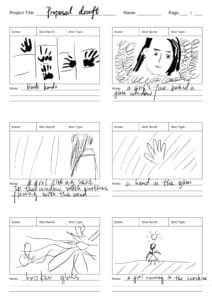
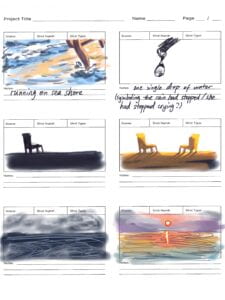
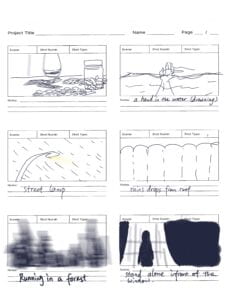
This is our storyboard. we found the color contrast from the beginning of building the framework. We can use black and white tones to show the depressed mood of the protagonist, and then by gradually brightening the tones, the colors gradually become richer to highlight the protagonist’s mood change for better optimism. But our storyboard is sometimes too optimistic, for example, we can not control the weather, so it is difficult to shoot the girl finally running in the sun (because it rained). So for this clip, we chose to use material from the Internet.
For the rest, we chose several images in the storyboard as metaphors for the girl’s emotions, such as pills, broken glass, raindrops, dark curtains to show sadness, and sunrise on the beach, sunshine, etc. to represent happiness.
In the actual shooting process, we used broken plates instead of glass, sunshine in the park instead of going to the beach and shifting curtains and tulle instead of shadows, taking into account the limitations of the raw materials and location.
Light and angle are also very important when shooting. For example, when I shoot the sun, there is a deliberate effort to retain the sun’s glow. When photographing medicine bottles, a slight shaking of the camera can make people empathize and feel sad. When we cut through the video we already had, we found that the tones of some of the footage did not blend harmoniously with the others, so we also replaced the shots. We also make the shot consistent with our subtitles so that the viewer looks more comfortable.
When editing voice-over, there was a lot of noise in the dorm, so I first used Audition for noise reduction. Also, because of the length, I selected some of the audio for editing, artificially lengthened the pauses and so on. When editing the audio, to make the transitions more natural, I first used keyframes to find the transition point of the audio, and then let the video transition at the keyframes. I participated in a workshop organized by LA and learned how to make special effects subtitles, how to use the nesting function for transitions, add filters to change tones, and other functions.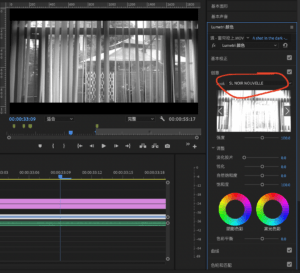
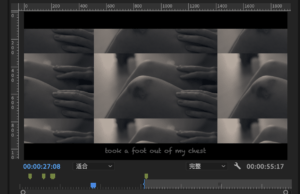
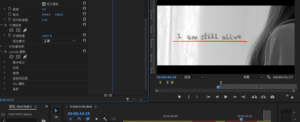
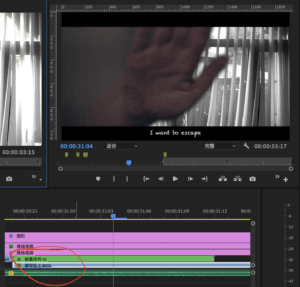
To give the subtitles a fade-in/fade-out effect, I find the opacity in the effective control and adjust the keyframe. (This was very hard to do), because dragging the captions required changing the keyframes again.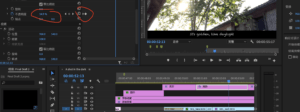
Because our story changed in stages, the BGM transition was very important, and it took me a lot of time. I needed to slowly reduce the volume of the first section of music and slowly increase the volume of the second section. After the peer review, I added the sound of water drops and then blacked out the screen to make the whole transition more natural. When I listened to it on my own computer there was no problem, but when he synthesized it on the classroom stereo it amplified the flaws, so I had to adjust it for a long time.
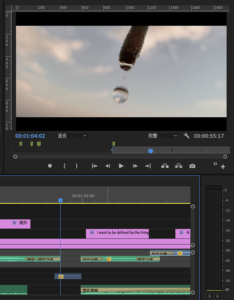
I also adjusted the size of the subtitles from 75 to 30, because what looks like a good size on a computer is magnified even more on a large screen.
C. Collaboration
I was responsible for writing the voice-over script. Melanie’s voice is perfect for recording voice-over, and she tries to use two vocal lines to show the changes in the girls’ emotions. I captured other anthropomorphic sounds, such as water drops, broken glass, and wind sounds. In addition, she happened to capture the rainbow outside the dormitory building and shot the evening sunset outside the school building, and the daylight in the park. We co-produced the subtitles, she was responsible for the subtitles before the mood change and I was responsible for the rest. I was mainly responsible for shooting the other video footage, as well as post-editing and audio processing work. I used the May Day holiday to shoot a lot of material, such as the sunlight by the river, the evening sun under the dormitory, dance performance, curtains, and fog, colored-pencils, broken plates, etc. I also added special effects to the whole video, etc. to make it look more artistic, when I finished editing the video and adding filters, Melanie could do a peer review and give me suggestions for improvement, and then I would do the debugging. Melanie is good at drawing and she has a good sense of color, so she was responsible for drawing two storyboards and I drew one. She gave me a lot of helpful advice when I was coloring and adding filters to the video.

D. Aesthetics & Results
As mentioned above, I have made many adjustments to the audio. I amplified the vocals and made the background music sound smaller as a secondary. I also made designs for the subtitles. I blurred some parts to make an intentionally sad emotion. In addition, I also toned down the video as a whole, giving the first half of the video an overall black-and-white tone when the girls are sad. In the second half, the saturation and contrast were increased. In addition, the camera angle is also important, such as shooting the girl’s head up when the camera follows the body, shooting the pill bottle when the lens shakes slightly, etc.
This is the final version of the video:
E. How to Improve
If I had more time, I would like our video to be more connected to real life so that it can give the audience more empathetic feelings. I would also like to replace the web footage used at the end and shoot myself running on the grass in real life because I really like this shot.
Appendix: there are a lot of videos we didn’t cut to the full video. Such as the stairs, the showering tap, the fog, and closing the door of the elevators.
Examples: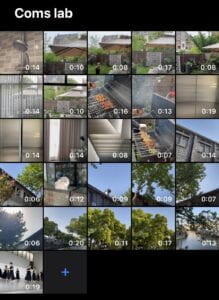
Really enjoy this course!!! I love Communications Lab!